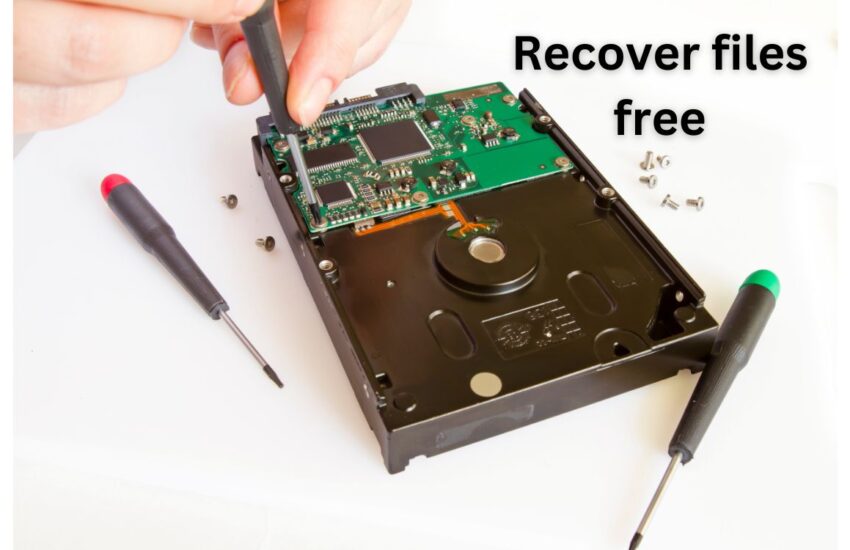Formatting a hard disk drive (HDD) often leads to losing important data. Many people don’t know this fact. Luckily, expert guides and advice are out there to help you to recover files from formatted HDD Free by Legit branded software. They ensure your lost files come back safely.
Key Takeaways to Recover Files From Formatted HDD:
- Data loss can occur when an HDD is formatted.
- Expert recovery guides and tips can help retrieve data from a formatted HDD.
- Restoring lost files securely is possible with the right tools and techniques.
- Preventive measures can help avoid data loss in the future.
- Data security and confidentiality are crucial during the recovery process.
- Stop Using the Drive Immediately: If you’ve accidentally formatted a drive, stop using it to prevent overwriting the data you want to recover. The sooner you start the recovery process, the better your chances.
- Choose the Right Recovery Software: Disk Drill, a reliable data recovery tool, can help you recover files from a formatted hard drive. Download the free version of Disk Drill and install it on your Windows or Mac. Avoid installing it on the same drive that suffered data loss to prevent further overwriting.
- Connect the Formatted Drive: Attach the formatted drive you wish to recover to your computer. Make sure it’s properly connected and recognized by the system.
- Launch Disk Drill: Run Disk Drill and select the formatted drive from the disk list. Click the “Search for lost data” button to initiate the scan.
- Preview and Recover: After the scan completes, Disk Drill will display a list of recoverable files. Preview the files to ensure they are intact. Select the lost files you want to recover and proceed with the recovery process.
Remember that successful recovery depends on factors like the type of drive (SSD or HDD) and the type of format performed (Quick or Full Format). If you act promptly and use the right software, you can retrieve your files from a formatted hard drive. Good luck! 🌟
Understanding HDD Formatting and Data Loss
The term “formatted HDD” is common in computer storage talk. But what does it actually mean? Understanding HDD formatting is key for knowing the potential for data loss. In this section, we’ll dive into HDD formatting and see how it can cause data loss.
What is HDD Formatting?
HDD formatting means getting a hard disk drive ready to store data. It does this by creating a file system on the drive. This allows the operating system to keep data organized. Formatting sets up the structure and partitions on the drive to store files.
Two main types of formatting are used: quick format and full format. Quick format deletes file system metadata for fast reuse. On the other hand, full format deletes the metadata and checks for bad sectors on the disk.
The Relationship Between Formatting and Data Loss
Formatting an HDD is normal to prepare a drive for use, but it can lead to data loss. Formatting erases all data from its file system. So, formatting a drive without backing up files first can mean losing important data.
Data loss can happen from human mistakes, malware, or system errors. Formatting doesn’t permanently erase data. It makes the space available for new data. If the space hasn’t been used yet, it’s possible to regain the lost data.
Preventing Data Loss from HDD Formatting
To stop data loss from HDD formatting, regularly back up your files. Backups mean you’ll keep a copy of important data, even if you accidentally format a drive. You can use cloud services, external drives, or NAS devices for backups.
Being careful and double-checking before formatting can also prevent data loss. Make sure you are working on the right drive before you start formatting. This reduces the risk of losing your files.
Knowing about HDD formatting and data loss helps you make smart choices with storage devices. Always back up your data and be careful to protect your valuable files.
Mac Data Retrieval: Tips and Techniques
If you’re a Mac user who has accidentally reformatted your hard drive, there’s hope. With the right steps, you can get your data back on your Mac.
First, stop using your computer right away if you notice data is missing. This stops more files from being overwritten. It helps save your lost data.
For recovery, try special software made for Macs. These programs scan your reformatted drive to find and recover lost files. They work with many types of files, like documents and videos.
Talking to experts in Mac data retrieval is another good move. They know how to deal with tricky data loss situations. They’ll find the best way to bring back your data.
DIY recovery without the right knowledge can make things worse. It might even cause permanent data loss. So, it’s smart to use good recovery software or get help from pros.
Data Recovery Tips for Mac Users:
- Immediately stop using your Mac after data loss to prevent overwriting.
- Use specialized data recovery software designed for Mac systems.
- Consult with professional data recovery services if needed.
- Avoid DIY recovery attempts without proper knowledge and tools.
- Regularly backup your data to prevent future loss.
 Following these tips can really help save your data on a Mac. Remember, fast action and getting professional help are key.
Following these tips can really help save your data on a Mac. Remember, fast action and getting professional help are key.
Windows Data Recovery: Step-by-Step Guide
Trying to get back data from a formatted hard drive can seem tough. But with clear guidance, Windows users can get their lost files back. This guide will show you how to recover data on Windows easily.

Gather the Required Tools
First, you need the right tools for a successful data recovery. You’ll need:
- A working computer or laptop
- An external storage device for the recovered data
- Windows-compatible data recovery software
Make sure your computer can run the recovery software without any problems.
Connect the Formatted HDD
Connect your hard drive to the computer using a USB or SATA cable. Check the connection is secure before moving on.
Install and Launch the Data Recovery Software
Then, put the data recovery software on your computer. Open the software after installing it. Wait for it to find your connected hard drive.
Select the Formatted HDD for Recovery
Select the drive you want to recover from the shown list. Be sure to pick the right one to avoid accidental formatting.
Start the Scan Process
Start scanning the selected hard drive to find files you can recover. The scan might take a while, depending on how much data there is. Be patient.
Don’t interrupt the scan by disconnecting the hard drive. This could cause data loss or corruption.
Preview and Recover the Lost Data
After the scan, you’ll see a list of files that can be recovered. Review these files carefully. Use the preview option to check the files are correct.
Choose the files you want back and pick where to save them. Don’t save them on the formatted hard drive to avoid losing more data.
Begin the Recovery Process
Now, hit “Recover” or “Restore” to start. The software will save your chosen files to the chosen place. The time it takes depends on how many files there are.
Verify the Recovered Data
When it’s done, check the files in the destination folder. Make sure everything is there and works. If some files are wrong, you might need to scan them again.
Well done! You’ve recovered your data from a formatted hard drive on Windows. Now you know how to get back lost files by yourself.
Expert Recovery Tools and Free Legit Software
Recover files from formatted HDD is easier with expert recovery tools and software. These powerful tools are made to help you get your files back quickly and effectively. Let’s look at some top options in the market, each with its own special features and benefits.
1. Stellar Data Recovery
Stellar Data Recovery is famous for its wide range of features and easy-to-use design. It uses advanced scanning to find lost or deleted files on formatted HDDs. You can recover photos, videos, documents, and emails. Its easy design makes recovering files simple, even if you’re not a tech expert.
2. EaseUS Data Recovery Wizard: EaseUS Data Recovery Wizard is a go-to for many needing to get data back from a formatted HDD. It’s easy to use for both beginners and pros. With its detailed scanning, EaseUS can find lost data with a high chance of success. It’s there for you, whether you accidentally formatted your HDD or your system crashed.
3. Disk Drill: Disk Drill works for both Mac and Windows users, which is great for those using different operating systems. Its strong scanning features help recover files from formatted HDDs, external drives, and damaged partitions. Its ease of use and support for many file types make it a top choice for recovering data.
4. Recuva: A popular free tool that offers both free and pro versions. It’s user-friendly and effective for file recovery.
5. MiniTool Power Data Recovery: MiniTool Partition Wizard Technician 2022 is a popular partition manager that allows users to create, resize, format, and professionally manage their hard disk partitions. Known for deep scanning capabilities.
These expert tools and software make retrieving data simpler and more successful. Choosing the right tool for your needs lets you confidently get your files back from a formatted HDD. Don’t let the fear of data loss stop you. Use these powerful tools to recover your data and move ahead.
Preventing Data Loss: Best Practices
Data recovery is important after losing files, but it’s best to avoid loss from the start. By adhering to top practices and backup strategies, you keep your files safe. Here are essential tips for data loss prevention:
Create Regular Data Backups
 One top strategy to avoid data loss is through regular file backups. Choose a backup method that fits, like cloud storage or external drives. Setting up auto backups ensures no important file is overlooked.
One top strategy to avoid data loss is through regular file backups. Choose a backup method that fits, like cloud storage or external drives. Setting up auto backups ensures no important file is overlooked.
Use Redundant Backup Systems
Having your data backed up in one place is risky. Use redundant backups, keeping your files in several spots. This action adds a safety net if your main backup fails.
Update Software and Hardware Regularly
Keeping tech updated helps prevent data loss. Updates fix security holes that might put your files at risk. Automatic updates keep your defenses strong without you having to remember.
Secure Your Network and Devices
It’s vital to safeguard your network and gadgets from unauthorized use. Use tough passwords and two-factor authentication. Keep your devices safe with trustworthy antivirus programs.
Educate and Train Employees
For business owners, teaching your team about preventing data loss is key. Train them on backups, password safety, and secure internet use. Have clear rules for managing private data to lower loss risks.
By sticking to these practices and having a solid backup plan, you’ll greatly cut data loss risks. Remember, it’s much better to prevent the loss than to recover after it happens.
Data Security and Confidentiality
Keeping your data safe and private is super important when getting back lost files. This is true whether you’re getting files back from a formatted hard drive or another type of storage. It’s key to protect your data while recovering it.
 Data security means keeping your data safe from people who shouldn’t see it. Confidentiality means only those allowed can access your information. It’s vital to pick recovery services or software that protect your data well.
Data security means keeping your data safe from people who shouldn’t see it. Confidentiality means only those allowed can access your information. It’s vital to pick recovery services or software that protect your data well.
Choosing a good data recovery service is one way to keep your data safe. Look for services with strong security steps, like encrypting your recovered data. You’ll feel better knowing your data is kept secret and safe.
It’s also important to be careful when you recover data by yourself. Use trusted recovery software with good security. Check reviews and make sure it encrypts your data during recovery.
Moreover, backing up your data to an external drive or the cloud is smart. It adds extra protection against losing data or facing risks. This keeps your recovered files even safer.
In short, always think about keeping your data safe and private when recovering files. Choose reliable services and secure software. These steps will keep your data protected and give you peace of mind.
Conclusion
Recover files from formatted HDD might seem tough, but it’s doable with expert help. It’s vital to understand HDD formatting and why data can get lost this way. No matter if you use Mac or Windows, there’s guidance and step-by-step help out there for you.
 Using expert tools and software is key in getting your files back. These tools can boost your success in data recovery. But, it’s always best to prevent data loss by backing up your data regularly.
Using expert tools and software is key in getting your files back. These tools can boost your success in data recovery. But, it’s always best to prevent data loss by backing up your data regularly.
Keeping your data safe and private during recovery is a must. Secure methods and precautions are necessary to protect your data. Recovering your data might be worrying, but with the correct info and help, you can get through it and get your files back.
Can I recover data from a drive that was securely erased or wiped?
Recovering data from a securely erased or wiped drive is an intricate task, and the chances of successful recovery depend on the method used for erasure. Here are some considerations:
- Secure Erase Methods:
- Zero-Fill (Zeroing): This method writes zeros to the entire drive. While it’s secure, it leaves no trace of the original data.
- Random Data (Pseudorandom): Overwrites the drive with random data. More secure than zero-filling.
- DoD 5220.22-M (3-Pass): Overwrites data three times with specific patterns.
- Gutmann Method (35-Pass): Extremely thorough, but not necessary for modern drives.
- Chances of Recovery:
- If the drive was securely wiped using the Gutmann Method, recovery is nearly impossible due to extensive overwriting.
- For other methods, the chances depend on factors like drive type (HDD or SSD) and subsequent usage.
- HDD vs. SSD:
- Hard Disk Drives (HDDs): Recovery might be possible if the drive was wiped using less secure methods. Specialized tools can sometimes retrieve overwritten data.
- Solid-State Drives (SSDs): SSDs use wear-leveling algorithms, making recovery challenging. Even if some data remains, it’s fragmented and encrypted.
- Professional Data Recovery Services:
- Consult professional data recovery services. They have specialized tools and expertise.
- Note that these services are costly and not always successful.
- DIY Recovery Attempts:
- Not Recommended: DIY recovery from securely wiped drives is risky.
- Read-Only Approach: Use a read-only tool (like TestDisk or PhotoRec) to scan the drive without altering its contents.
- Check for Residual Data: Sometimes remnants of old files remain in unallocated space.
- Prevent Further Writes:
- Avoid writing anything to the drive. New data could overwrite remnants of the old data.
Remember that securely wiped drives are intentionally made unrecoverable. If the data is critical, consult professionals immediately. Otherwise, consider it permanently lost. 🌟
